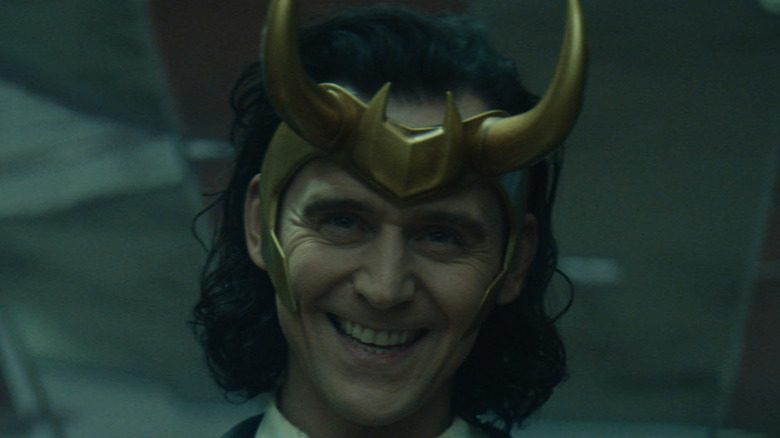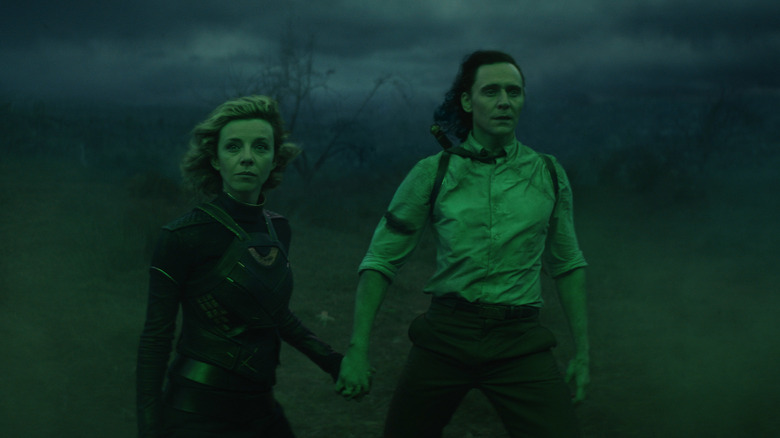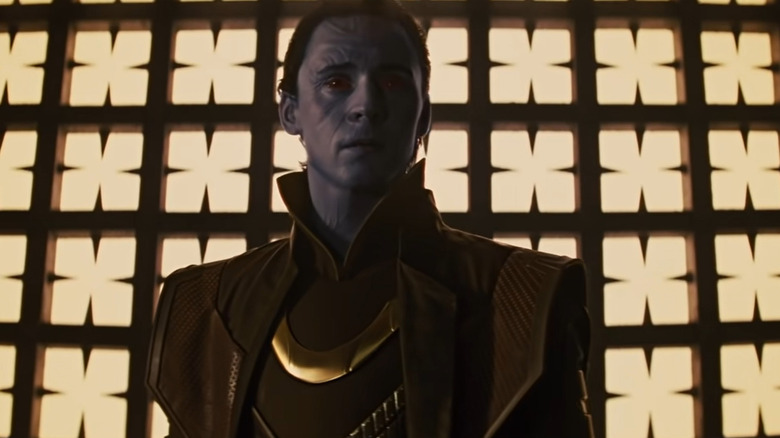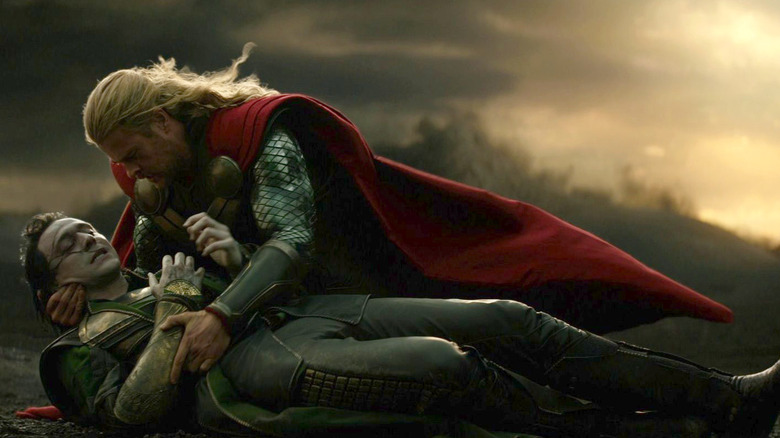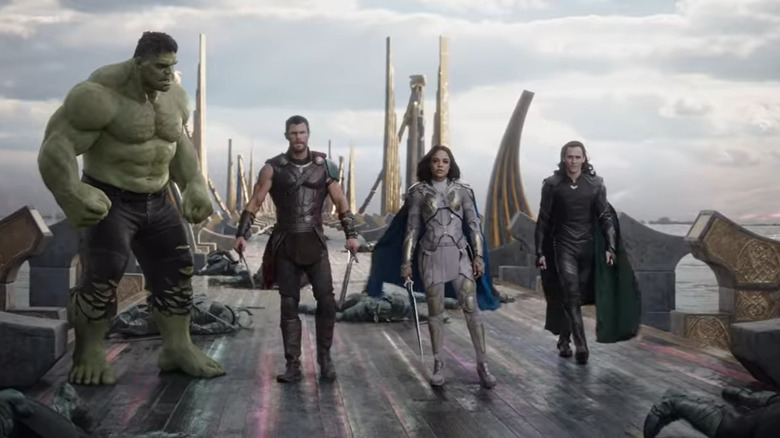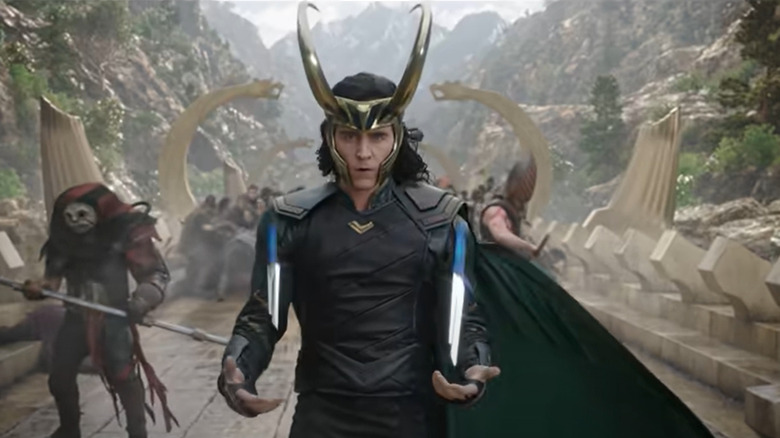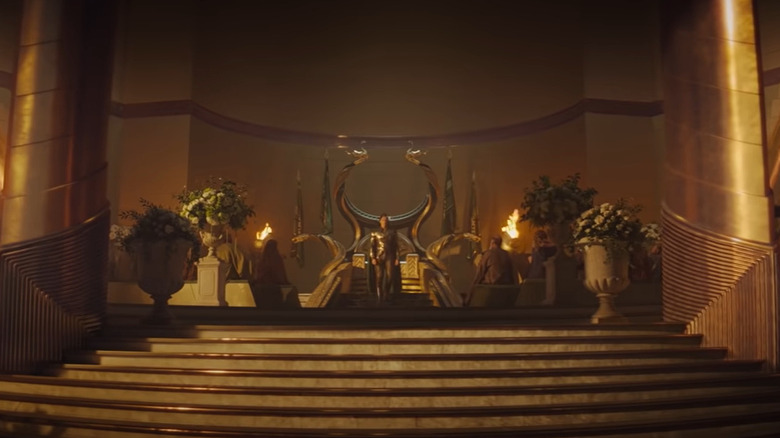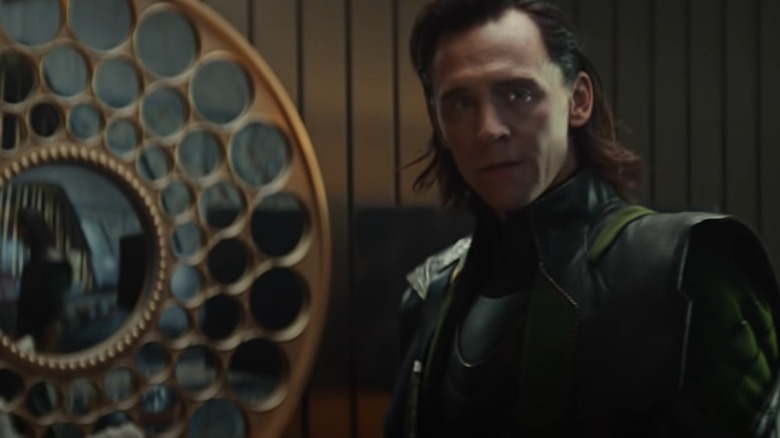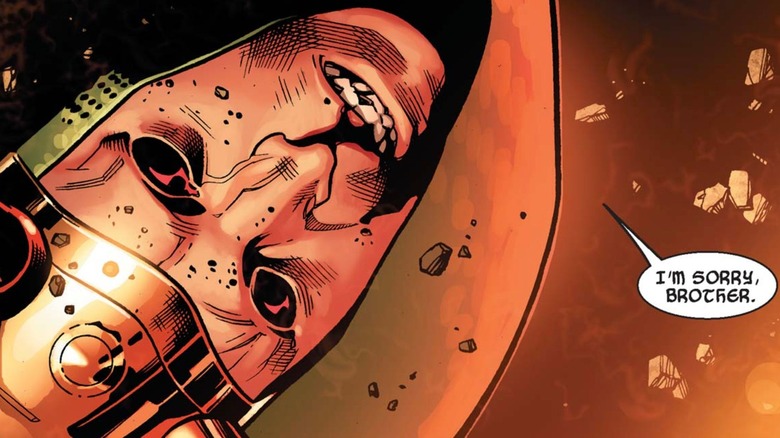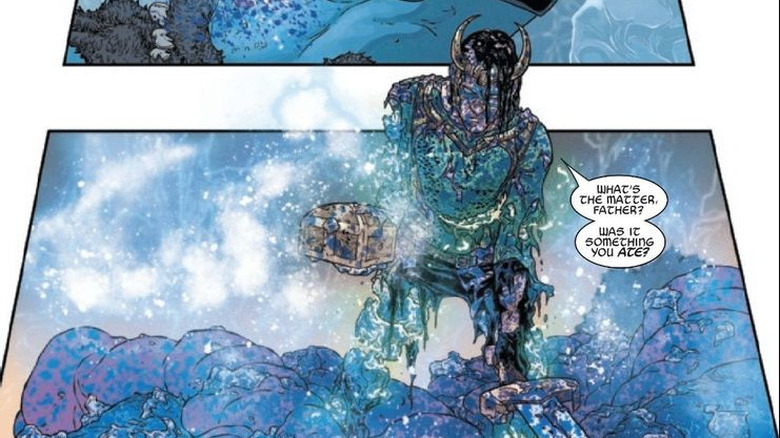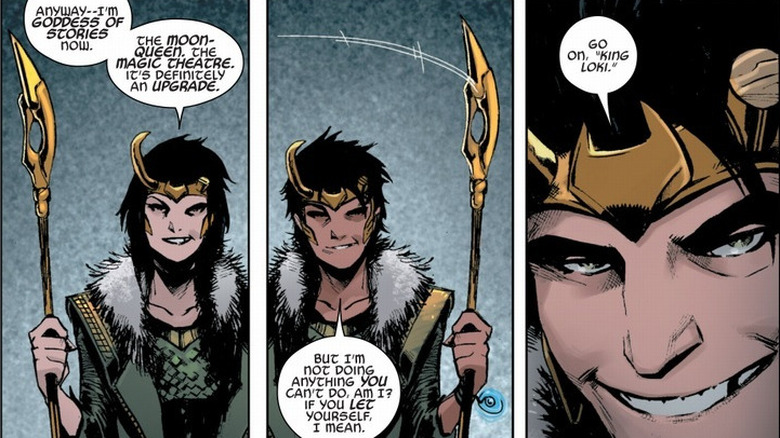Ways Marvel Lied To You About Loki
As the God of Mischief, Loki's story in Marvel Comics and the Marvel Cinematic Universe has been, well, mischievous.
Like nearly every other Marvel character — superhero, supervillain or somewhere in between — Loki doesn't have a tidy story that fits neatly on the multiple timelines. And like many other comic characters, there have been many iterations of Loki over the decades with different ages, relationships, and signature looks. Marvel has also continuously tweaked Loki's personality and level of villainy to fit his many roles within the MCU — from the villainy he perpetrated in 2012's "Avengers" to the many big and small redemption arcs leading to 2021's "Loki" series.
But then there are the times where Marvel just plain lied about Loki in the comics and in the MCU. There are scenes Marvel teased in movie trailers that never actually happened, as well as Loki's many cinematic "deaths" that were undone. There's even a comic storyline where Loki retcons himself, in order for Marvel to introduce yet another version of the character.
Most of these lies, retcons, and fakeouts are subtle and harmless, but some are baffling and expose stark inconsistencies within the continuity of the comics and the MCU. Here are some of the most notable examples of Marvel lying about Loki.
His magical powers
As a god, Loki has shown off a wealth of impressive powers throughout his stories in the MCU. All of them are rooted in Asgardian magic as taught to him by his adopted mother, Frigga (Rene Russo), Thor's biological mother. He's shown he can shapeshift, cast duplicates of himself as visual tricks and conceal himself. He also has the power of creating illusions, and in Episode 2 of the "Loki" series, he explains to Mobius (Owen Wilson) the differences between projecting illusions and duplication.
However, the series also shines a light on a big continuity error in the MCU when it comes to Loki's powers — his inability to control minds. A key plot point, especially toward the end of the first season, is Loki variant Sylvie's (Sophia Di Martino) ability to enchant minds. This enchantment ability allows her to access people's memories and even inhabit and wield their bodies while they're mentally imprisoned.
While Sylvie closely guards this power, she imbues confidence in Loki that he, too, can enchant Alioth alongside her despite his argument otherwise. If Loki doesn't have the ability to enchant or control minds, then what was he doing in his first appearance in "Thor"?
In that film's end-credits scene, it's revealed that Loki was influencing scientist Erik Selvig to experiment with the Tesseract — all from way out in the abyss of the cosmos. There's also the scene in "Thor: Ragnarok" when he touches Valkyrie's head, bringing forth her memories of the brutal battle with Hela where all her sisters died.
Showing Loki's enchantment struggle may be an oversight by Marvel or a bit of a retcon for the march into Phase 4, but it's clear from his past appearances that he does have the ability to control minds.
His origins
Loki's true parentage is more of a (short) hidden truth, but in the MCU, Marvel used Odin (Anthony Hopkins) to hide the God of Mischief's origins as a tool in Asgard's relations with the Frost Giants. As Loki discovers in "Thor," he's actually the son of the Frost Giants' leader, Laufey, not the king of Asgard.
Though Loki had been mischievous throughout his childhood and young adult life, him learning of his origins and that his father hid the truth from him for so long were key in fostering anger, resentment and villainy in the trickster god. Learning that he was abandoned by the Frost Giants for being a "runt" and realizing why Thor was always the favored son only continued to fuel Loki's anger at being tricked.
The impact of Odin's lies came full circle in moments in the live-action series, which further proved the inaccuracy of Loki being wholly bad. When Mobius shows a few different Loki variants that have been caught by the Time Variance Authority, one of them is a tall, blue-skinned Frost Giant Loki. With the Sacred Timeline dictating that Loki wasn't supposed to know about his parentage at first, one might assume Frost Giant Loki's nexus event was discovering — and possibly accepting — his true origins.
In Norse mythology, most sources have Loki as the offspring of Laufey and the jötunn (Frost Giant) Farbauti. According to Smithsonian Magazine, other sources describe Loki and Odin becoming "blood brothers." And, while Marvel portrays Thor and Loki as brothers, their mythological origins rarely describe them interacting with one another.
His deaths
Loki has become one of those characters in the MCU that "dies" in almost every movie he's in. In fact, he's died or appeared to have died at least four times — three fakeouts and one actual death at the hands of Thanos in "Avengers: Infinity War."
The end of 2011's "Thor" shows Loki seemingly dying after falling from the destroyed Bifrost bridge and into the abyss of the cosmos. However, that film's post-credits scene shows Loki in a mirror beside Erik Selvig, implying the God of Mischief is mind-controlling the scientist to study a mysterious object later confirmed to be the Tesseract.
Loki defies death again in another post-credits scene, this time in "Thor: The Dark World." The end of the film shows Loki jumping in front of an attack on Thor during the battle against Dark Elf Malekith. Loki is stabbed in the chest and dies in Thor's arms. But not so fast — Loki is, in fact, fine and impersonating Odin in the extra scene. Loki actor Tom Hiddleston even explained that his character's death in this film was originally written as an actual death.
The final fakeout death happened in the "Loki" series, where he is "pruned" from the timeline by the TVA. Throughout the series, the TVA boasted that pruning essentially wipes a person from existence. But a post-credit scene shows pruned variants don't in fact die, but rather are sent to the Void at the end of time.
As for a true death, Loki quite literally has the life crushed out of him by Thanos in "Infinity War." That Loki is dead dead — he doesn't return in a post-credit scene or in the next movie, "Endgame." But thanks to the nature of the MCU's new multiverse, who knows how many versions of Loki are still alive and well, for now.
The Revengers
The MCU is no stranger to including epic scenes in its trailers but never actually showing those moments in the final films. In trailers for "Thor: Ragnarok," there are two shots of Loki that didn't actually make it into the final film.
The first is an epic team-up shot showing Hulk, Thor, Valkyrie and Loki standing ready for battle on the Rainbow Bridge in Asgard. The bridge appears to have seen better days, with a bunch of bodies lying behind the characters.
These four were dubbed the "Revengers" and assembled by Thor in order to escape Sakaar and defeat Thor's half-sister Hela. While the ragtag Revengers did team up in "Thor: Ragnarok," this particular scene of all four of them on the bridge didn't happen in the final film. Thor, Valkyrie, Hulk and Loki were all mostly separate throughout the battle until the end.
The Revengers also exist in the world of Marvel Comics, first popping up in "New Avengers" #1 from 2011. That group is Wonder Man, D-Man, Anti-Venom, Virtue, Captain Ultra, Goliath, Atlas, Devil-Slayer and Century.
Classic knife-wielding Loki
The other scene of Loki from the "Thor: Ragnarok" teaser trailer that never happened in the film is a glamorous shot of Loki — full golden horns, green cape and all — flipping his trademark knives on a bridge as a battle rages around him. The shot is made even better in slow motion while Led Zeppelin's "Immigrant Song" plays.
The bridge and this particular battle are never recreated in the final version of the film, making it now just a really cool hype shot. However, the spot does look slightly similar to the place where Heimdall (Idris Elba) was trying to guide innocent Asgardians away from Hela's wrath. In the movie, Loki does help the Asgardian refugees escape by leading the Sakaaran rebels to battle against Hela's undead forces. He just doesn't wear his signature large golden horn helmet while he does it.
It appears this epic trailer shot was included to tease Loki's eventual heroism and team-up with the Revengers in "Thor: Ragnarok."
Loki, King of Asgard
There are two key scenes in the "Loki" trailer that don't appear anywhere in the first season of the live-action series. The inclusion of this footage was possibly a way for Marvel to tease the version of Loki fans would get in the Disney+ series — i.e. 2012 Loki burdened with "glorious purpose" and with aspirations to rule Asgard and Earth (Midgard).
One shot in the trailer shows Loki, bedecked in Asgardian royal clothing, standing in front of a throne. Just based on the trailer, it would be safe to assume Loki finally achieves his goal of becoming king of Asgard in the "Loki" series.
But as fans know, that didn't happen. Instead, by the end of the first season, Loki has transformed into somewhat of a hero — or, at least this version has grown worthy of his redemption arc. Moments before meeting the man who created the TVA to protect the "rightful" flow of time, Miss Minutes even offers both Loki and Sylvie the opportunity to achieve their grandest goals, including a seat on the throne of Asgard. But Loki refused, choosing instead to protect the multiverse and its variants.
The 2012 Tesseract-stealing Loki may not have become king of Asgard, but the King Loki we see in the trailer might be one his many variants on another timeline.
Returning to 2012 and Stark Tower
The other notable scene from the "Loki" trailer that was cut for the actual series teased Loki returning to 2012 New York City. Specifically, it shows him back in Stark Tower. The scene depicts him glancing around as if he's reflecting on what led him to this point and also murmuring "glorious." Noticeably absent on Loki is his signature sly smile and the face injuries he sported right before being arrested by the TVA.
Like King Loki, this return to 2012 moment also did not happen in the final version of the series — and because of the setting and time period, it's unlikely that this shot shows another Loki variant. This scene from the trailer may have suggested to fans that this six-episode series would be a limited one with a clear, closed finale where Loki returns to his spot on the timeline and continues his journey with new insight from the TVA. But it didn't happen, and instead of a limited run of "Loki," fans got another season of the God of Mischief — along with the chaotic opening to Phase 4 of the MCU.
Retconning himself
Marvel hasn't just faked out or retconned aspects about Loki in the MCU films. There are also several comic book moments where Loki seemingly dies for good, only to reappear issues or even years later.
The events of Marvel's 2010 "Siege" four-issue series follow a corrupted Norman Osborn as he tries to take over Asgard, which was in the United States in this arc. At the beginning of the series, Loki manipulates Osborn to create a massacre in order to justify his siege. An intense, brutal battle between Osborn's forces and the Avengers ensue, and by the last issue the super team have to take on the Void (the dark version of Sentry) in order to save the city. When Loki has a spark of guilt and asks for Odin's help to boost the Avengers' powers, the Void slaughters Loki, realizing he has switched sides.
But instead of truly dying, Loki is reincarnated as an entirely new version of himself — Kid Loki — in January 2011's "Thor" #617. As Kid Loki, also named Serrure in this issue, the trickster god was reborn but with no memories of his past life or powers. While Loki eventually learns of his past and how he was reborn through the spirit of his former self (also known as Prime Loki), the character essentially retconned himself to make way for a new version of the God of Mischief.
Eaten by his own father
Though not the central story of this Marvel comics series, Loki does get eaten by his own father in the "War of the Realms" run.
This series was a massive team-up of nearly all the major players seen in both the comics and in the cinematic universe. The big baddie is Malekith and his Dark Council forces, who are trying to conquer the Ten Realms. Loki is once again berated by both sides of the conflict for his supposed betrayal and tricks on Malekith and all the heroes trying to fight the Dark Elf. While Loki did appear to be on Malekith's side at first, when the elf's war comes to Earth, Loki throws his allegiance behind the Avengers and all the other superheroes trying to save the planet.
Loki's biological father, the Frost Giant Laufey, was also part of Malekith's Dark Council and retaliated against Loki by eating him alive.
By the end of the "War of the Realms," however, Malekith was defeated and Loki managed to survive inside his father's gut using sorcery. He also had Heimdall's trusty sword, which he used to carve his way out of his father. Loki was alive, but he wasn't pretty to look at — partly dismembered, partly digested and using magic to keep his body together.
Killed by his evil future self
In this fakeout death/reincarnation, there are technically three different versions of Loki. In his solo comic series, "Agent of Asgard," the young adult trickster god is recruited for missions on behalf of the All-Mothers of Asgardia. But while Loki tries to reinvent himself as more of a mischievous anti-hero, the All-Mothers manipulate events to try to bring back the more villainous version of Loki.
When it's revealed that Loki (imbued with the spirit of his past self, Prime Loki) killed the spirit of Kid Loki, the Asgardian agent is exiled to Earth. There, he encounters his evil future self, King Loki, who unbeknownst to him made a deal with the All-Mothers to help bring Loki back to the villains side. While King Loki ties up and sets the other Loki on fire, his future self tells him about all the evil things he's done and will do.
Loki seemingly burns to death, but several issues later (about eight months in this timeline), he returns — this time as the God of Stories. In this reincarnation, Loki sends King Loki back to his future and realizes that lies are just stories — and he's the god of them both.
